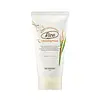What's inside
What's inside
 Key Ingredients
Key Ingredients

 Benefits
Benefits

 Concerns
Concerns

 Ingredients Side-by-side
Ingredients Side-by-side

Sucrose
HumectantWater
Skin ConditioningSodium Cocoyl Glutamate
CleansingPEG-150
HumectantSaccharum Officinarum Extract
MoisturisingPEG-32
HumectantSodium Cocoyl Glycinate
CleansingGlycerin
HumectantTrehalose
HumectantBetaine
HumectantButylene Glycol
HumectantSorbitol
HumectantSodium PCA
HumectantDimethicone
EmollientPhenoxyethanol
PreservativeEthylhexylglycerin
Skin ConditioningParfum
MaskingCaramel
Cosmetic ColorantDisodium EDTA
Threonine
Arginine
MaskingGlycine
BufferingHydrogenated Lecithin
EmulsifyingPyrus Malus Fruit Extract
Skin ConditioningCitrus Limon Fruit Extract
MaskingCitrus Aurantium Dulcis Fruit Extract
MaskingCarica Papaya Fruit Extract
Skin ConditioningAlanine
MaskingLysine
Skin ConditioningAlcohol Denat.
AntimicrobialGlutamic Acid
HumectantProline
Skin ConditioningSerine
MaskingTocopheryl Acetate
AntioxidantCeramide NP
Skin Conditioning1,2-Hexanediol
Skin ConditioningSarcodon Aspratus Extract
AntioxidantRice Ferment Filtrate
Skin ConditioningLepidium Meyenii Root Extract
Skin ConditioningCholesterol
EmollientSucrose, Water, Sodium Cocoyl Glutamate, PEG-150, Saccharum Officinarum Extract, PEG-32, Sodium Cocoyl Glycinate, Glycerin, Trehalose, Betaine, Butylene Glycol, Sorbitol, Sodium PCA, Dimethicone, Phenoxyethanol, Ethylhexylglycerin, Parfum, Caramel, Disodium EDTA, Threonine, Arginine, Glycine, Hydrogenated Lecithin, Pyrus Malus Fruit Extract, Citrus Limon Fruit Extract, Citrus Aurantium Dulcis Fruit Extract, Carica Papaya Fruit Extract, Alanine, Lysine, Alcohol Denat., Glutamic Acid, Proline, Serine, Tocopheryl Acetate, Ceramide NP, 1,2-Hexanediol, Sarcodon Aspratus Extract, Rice Ferment Filtrate, Lepidium Meyenii Root Extract, Cholesterol
Water
Skin ConditioningMyristic Acid
CleansingGlycerin
HumectantStearic Acid
CleansingPotassium Hydroxide
BufferingOryza Sativa Bran Water
MaskingLauric Acid
CleansingLauryl Betaine
CleansingGlyceryl Stearate Se
EmulsifyingSodium Cocoyl Apple Amino Acids
Skin ConditioningPolyquaternium-7
Sodium Chloride
MaskingCetearyl Olivate
Panthenol
Skin ConditioningSorbitan Olivate
EmulsifyingHexylene Glycol
EmulsifyingAllantoin
Skin ConditioningSodium Benzoate
MaskingDisodium EDTA
Oryza Sativa Extract
AbsorbentSodium Hyaluronate
HumectantCitric Acid
BufferingButylene Glycol
HumectantAspergillus Ferment
Skin ConditioningCeramide AP
Skin Conditioning1,2-Hexanediol
Skin ConditioningParfum
MaskingWater, Myristic Acid, Glycerin, Stearic Acid, Potassium Hydroxide, Oryza Sativa Bran Water, Lauric Acid, Lauryl Betaine, Glyceryl Stearate Se, Sodium Cocoyl Apple Amino Acids, Polyquaternium-7, Sodium Chloride, Cetearyl Olivate, Panthenol, Sorbitan Olivate, Hexylene Glycol, Allantoin, Sodium Benzoate, Disodium EDTA, Oryza Sativa Extract, Sodium Hyaluronate, Citric Acid, Butylene Glycol, Aspergillus Ferment, Ceramide AP, 1,2-Hexanediol, Parfum
Ingredients Explained
These ingredients are found in both products.
Ingredients higher up in an ingredient list are typically present in a larger amount.
1,2-Hexanediol is a synthetic liquid and another multi-functional powerhouse.
It is a:
- Humectant, drawing moisture into the skin
- Emollient, helping to soften skin
- Solvent, dispersing and stabilizing formulas
- Preservative booster, enhancing the antimicrobial activity of other preservatives
Butylene Glycol (or BG) is used within cosmetic products for a few different reasons:
Overall, Butylene Glycol is a safe and well-rounded ingredient that works well with other ingredients.
Though this ingredient works well with most skin types, some people with sensitive skin may experience a reaction such as allergic rashes, closed comedones, or itchiness.
Learn more about Butylene GlycolDisodium EDTA plays a role in making products more stable by aiding other preservatives.
It is a chelating agent, meaning it neutralizes metal ions that may be found in a product.
Disodium EDTA is a salt of edetic acid and is found to be safe in cosmetic ingredients.
Learn more about Disodium EDTAGlycerin is already naturally found in your skin. It helps moisturize and protect your skin.
A study from 2016 found glycerin to be more effective as a humectant than AHAs and hyaluronic acid.
As a humectant, it helps the skin stay hydrated by pulling moisture to your skin. The low molecular weight of glycerin allows it to pull moisture into the deeper layers of your skin.
Hydrated skin improves your skin barrier; Your skin barrier helps protect against irritants and bacteria.
Glycerin has also been found to have antimicrobial and antiviral properties. Due to these properties, glycerin is often used in wound and burn treatments.
In cosmetics, glycerin is usually derived from plants such as soybean or palm. However, it can also be sourced from animals, such as tallow or animal fat.
This ingredient is organic, colorless, odorless, and non-toxic.
Glycerin is the name for this ingredient in American English. British English uses Glycerol/Glycerine.
Learn more about GlycerinParfum is a catch-all term for an ingredient or more that is used to give a scent to products.
Also called "fragrance", this ingredient can be a blend of hundreds of chemicals or plant oils. This means every product with "fragrance" or "parfum" in the ingredients list is a different mixture.
For instance, Habanolide is a proprietary trade name for a specific aroma chemical. When used as a fragrance ingredient in cosmetics, most aroma chemicals fall under the broad labeling category of “FRAGRANCE” or “PARFUM” according to EU and US regulations.
The term 'parfum' or 'fragrance' is not regulated in many countries. In many cases, it is up to the brand to define this term.
For instance, many brands choose to label themselves as "fragrance-free" because they are not using synthetic fragrances. However, their products may still contain ingredients such as essential oils that are considered a fragrance by INCI standards.
One example is Calendula flower extract. Calendula is an essential oil that still imparts a scent or 'fragrance'.
Depending on the blend, the ingredients in the mixture can cause allergies and sensitivities on the skin. Some ingredients that are known EU allergens include linalool and citronellol.
Parfum can also be used to mask or cover an unpleasant scent.
The bottom line is: not all fragrances/parfum/ingredients are created equally. If you are worried about fragrances, we recommend taking a closer look at an ingredient. And of course, we always recommend speaking with a professional.
Learn more about ParfumWater. It's the most common cosmetic ingredient of all. You'll usually see it at the top of ingredient lists, meaning that it makes up the largest part of the product.
So why is it so popular? Water most often acts as a solvent - this means that it helps dissolve other ingredients into the formulation.
You'll also recognize water as that liquid we all need to stay alive. If you see this, drink a glass of water. Stay hydrated!
Learn more about Water